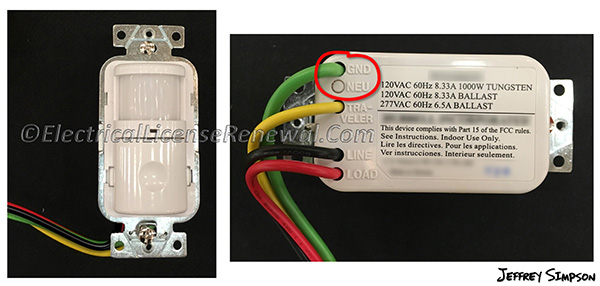404.2(C) Switches Controlling Lighting Loads.

Code Change Summary: Revisions were made to the requirement to provide a grounded neutral conductor at specific switch locations.
Section 404.2(C) requires a neutral conductor to be installed at specific lighting switch locations. Not all light switches require or even use a neutral but some have electronic circuitry that requires a current return path to complete the circuit even when the device is in the off position. Switch-type occupancy sensors (see image) are a good example.
For years, manufacturers have been producing occupancy sensor and motion control type switches that use the equipment grounding conductor of the circuit as the normal neutral current return path. A small amount of neutral current imposed on the equipment grounding conductor is considered to be harmless. For example, as part of the listing and certification process, a listed appliance can have no more than ½ mA of current leakage flowing along the equipment ground return path. A typical Class A type GFCI device is designed to trip when between 4mA and 6mA of current leakage on the equipment ground path has been detected.
The problem arises when 10 or so occupancy sensor type switches are installed on the same circuit which leads to 5mA or more of current traversing the equipment grounding return path. For this reason, the 2011 NEC® began requiring a grounded neutral conductor to be present at each switch box.
The revisions to this section include rewording a few of the rules into positive text and requiring an insulated grounded neutral conductor to be installed (and connected) when switching devices require line-to-neutral voltage to operate the electronics of the switch. The previous code language only required the grounded neutral conductor to be “provided” at the switch location but made no mention of it being connected or used.
As well, a new exception was added that relaxes this requirement for existing installations made prior to January 1, 2020. This should give manufacturers time to create electronic switches that are equipped with a neutral conductor terminal.
The new exception goes on to say that the connection of the neutral conductor does “not apply to replacement or retrofit switches installed in locations prior to local adoption of 404.2(C) and where the grounded conductor cannot be extended without removing finish materials. The number of electronic lighting control switches on a branch circuit shall not exceed five, and the number connected to any feeder on the load side of a system or main bonding jumper shall not exceed 25”. These values will ensure than current returning on the equipment grounding conductors from electronic switches will be kept to safe levels.
Below is a preview of the NEC®. See the actual NEC® text at NFPA.ORG for the complete code section. Once there, click on their link to free access to the 2017 NEC® edition of NFPA 70.
2014 Code Language:
404.2(C) Switches Controlling Lighting Loads.
The grounded circuit conductor for the controlled lighting circuit shall be provided at the location where switches control lighting loads that are supplied by a grounded general-purpose branch circuit for other than the following:
(1) Where conductors enter the box enclosing the switch through a raceway, provided that the raceway is large enough for all contained conductors, including a grounded conductor
(2) Where the box enclosing the switch is accessible for the installation of an additional or replacement cable without removing finish materials
(3) Where snap switches with integral enclosures comply with 300.15(E)
(4) Where a switch does not serve a habitable room or bathroom
(5) Where multiple switch locations control the same lighting
load such that the entire floor area of the room or space is visible from the single or combined switch locations
(6) Where lighting in the area is controlled by automatic means
(7) Where a switch controls a receptacle load.
2017 Code Language:
404.2(C) Switches Controlling Lighting Loads.
The grounded circuit conductor for the controlled lighting circuit shall be installed at the location where switches control lighting loads that are supplied by a grounded general-purpose branch circuit serving bathrooms, hallways, stairways, or rooms suitable for human habitation or occupancy as defined in the applicable building code. Where multiple switch locations control the same lighting load such that the entire floor area of the room or space is visible from the single or combined switch locations, the grounded circuit conductor shall only be required at one location. A grounded conductor shall not be required to be installed at lighting switch locations under any of the following conditions:
(1) Where conductors enter the box enclosing the switch through a raceway, provided that the raceway is large enough for all contained conductors, including a grounded conductor
(2) Where the box enclosing the switch is accessible for the installation of an additional or replacement cable without removing finish materials
(3) Where snap switches with integral enclosures comply with 300.15(E)
(4) Where lighting in the area is controlled by automatic means
(5) Where a switch controls a receptacle load.
The grounded conductor shall be extended to any switch location as necessary and shall be connected to switching devices that require line-to-neutral voltage to operate the electronics of the switch in the standby mode and shall meet the requirements of 404.22.
Exception: The connection requirement shall become effective on January 1, 2020. It shall not apply to replacement or retrofit switches installed in locations prior to local adoption of 404.2(C) and where the grounded conductor cannot be extended without removing finish materials. The number of electronic lighting control switches on a branch circuit shall not exceed five, and the number connected to any feeder on the load side of a system or main bonding jumper shall not exceed 25. For the purpose of this exception, a neutral busbar, in compliance with 200.2(B) and to which a main or system bonding jumper is connected shall not be limited as to the number of electronic lighting control switches connected.